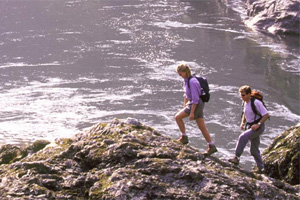
 A couple decades ago, my then 28-year-old body roamed hiking trails like an all-wheel drive automobile maneuvers over an icy roadway. My day job included a good dose of physical activity that kept my human carcass in decent physical condition. Now, when I plan for a set of challenging hikes, the word "workouts" appears on my trip planning list. But no matter what age of hiker you are, an exercise regimen will improve your hiking experience. It's surprising how much a little exercise will do for your hiking strength, stamina, and mental confidence.
A couple decades ago, my then 28-year-old body roamed hiking trails like an all-wheel drive automobile maneuvers over an icy roadway. My day job included a good dose of physical activity that kept my human carcass in decent physical condition. Now, when I plan for a set of challenging hikes, the word "workouts" appears on my trip planning list. But no matter what age of hiker you are, an exercise regimen will improve your hiking experience. It's surprising how much a little exercise will do for your hiking strength, stamina, and mental confidence.
Hundreds of exercises have been designed to strengthen every body part strapped to the human skeleton. Every sport has a specific set of exercises to hit the muscle sets that are the engine that drives the body to handle the specific sport's physical demands. Hiking requires its share physical loads, with only a short list of exercises being able to deliver a prepared body. Exercise programs and routines are as challenging to stay with them as they can be to follow. Fortunately for hikers, spending three days per week doing a handful of exercises, is a plan that is a reality to staying with it.
Preferably, a full-body workout that is accomplished by circuit training (several exercises done in succession, with a brief rest in between exercises) leads to best overall results. Hundreds of workout plans are available on the internet and in various books lining bookstore and library shelves. Workouts that require no equipment are considered portable — easy to do in a hotel room while traveling. Select a workout plan that includes using the body's weight for strength training (push ups, squats, etc.), which most of those workouts include cardio work such as jumping jacks, high steps and running in place. Keeping the plan simple, fun, and effective, is the key to keeping a workout on your weekly agenda. Also, dedicating just three days per week will not burn you out on exercising.
Specific exercises, such as step-ups (from a standing position, simply step up on to a sturdy chair and step back down), is an important exercise that hits the primary hiking muscles. To add resistance to this base exercise, do it with a daypack strapped on, and a few bottles of water thrown in for more weight. The point is to focus on the leg muscles and body core (stomach, back) which supports the majority of hiking moves on the trail. Build your own exercise routine around the step-up movement that includes cardio and body core muscles. Again, a long list of various exercises exist and selecting a few that fit your hiking needs and your body will deliver results — on the trail and in everyday life.
- 3994 views

